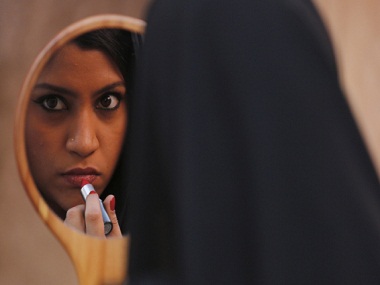By Shruti Sunderraman
Pahlaj Nihalani must be a tense man today. Ban as he might, Alankrita Shrivastava’s Lipstick Under My Burkha opened to applause in cinemas.
A lipstick fought against months of censorship with a rouge-tinted smile, underlining autonomous voices — Shrivastava’s and her cast’s. But what about a lipstick makes the likes of Nihalani uncomfortable in their privileged seats?
He should talk to my sister-in-law Neha. She does not share her lipstick pouch. The pouch is home to enviable shades of reds, pinks, maroons and even rainforest browns. I never had the guts to wear lipstick in college but I was endlessly fascinated by that lipstick pouch.
She’d not reserve her lipsticks only for occasions, but would smear her lips with the red-of-the-day every day. But something about Neha wearing lipstick to family gatherings created a ripple in the air. A couple of times, I’d caught older women in the family look away from her face while talking to her — uncharacteristically rude of them, I thought.
Sometimes, I’d be ushered away when I expressed my desire to apply her lipsticks.
“Everything else about your outfit is so decent, why will you ruin it with that… thing,” my father had once remarked when I came out of Neha’s room with cherry-painted lips. He would not even call it ‘lipstick’.
What was it about lipstick that made him so uncomfortable? It can’t be the colour red. When no one objects to red on the forehead, why the hooplah over red on the lips? The displaced geography of redness seemed to reflect misplaced morality.
Also read: My politically charged lipstick — Notes from a lipstick-loving feminist’s diaryNeha is not alone. History is her witness. In Ancient Greece, women were frowned upon for painting their lips because ‘only prostitutes painted their lips’.
In the Renaissance period, English pastors called the lipstick ‘devil’s work’ and equated red on the lips to be ‘demon-paint’. So, you know what Queen Elizabeth I did? She wore the goddamn demon-paint on her lips to send a message to the clergy — STFU.
To Queen E, wearing lipstick reinforced her political autonomy. More recently, Symone Sanders, who served as national press secretary for Democratic presidential candidate Bernie Sanders, seems to have taken a leaf out of the Queen’s book. She was constantly seen with a statement blood-wine lipstick throughout the campaign.
In an interview , she says, “I don’t think there are a lot of bald black girls on the political scene, at least that the American people get to see every day, so I want to represent for brown girls, all shades of brown.”
Even Aishwarya Rai Bachchan was subjected to endless flak and memes for sporting a fun purple shade of lipstick at the Cannes Film Festival in 2016. She superbly brushed all them memes aside, saying, “It’s the time for creative artists to have their Picasso moments. Sometimes people get it and sometimes they don’t… And that’s fine! It’s really not my fulcrum of existence and I have enjoyed it.”
Looking at these women, it is easy to conclude (and many would be eager to conclude) that lipstick is a sign of defiance.
But to me, it appears to be beyond defiance. It is an assertion. An assertion that I am a woman who recognises your power but I’m also self-assured about my own. While defiance tries to exclude, assertion includes. Which makes it easy to fight defiance but not assertion. This is what scares a patriarchal mindset and makes it run from the sight of feist-coloured lips. (THE POWER OF THE FEIST COMPELS YOU !)
Assertion is the prime suspect in Lipstick Under My Burkha . While the promotions of the film lead you to believe that sex is central to the plot, the movie delightfully guides your empathy to the assertion the protagonists are trying to find in their voices. It highlights their struggles to retain autonomy over their own bodies and more significantly, over their own lives. Sex is just a part of it. The lipstick is not a sign of promiscuity in the film, but serves as a window of freedom from oppressive mindsets.
Leela (Aahana Kumra) and Usha (Ratna Pathak Shah) wear lipstick to express themselves as sexual beings while Shireen (Konkona Sen Sharma) wears it to further her professional ambitions. Rehana (Plabita Borthakur) wears it to… breathe. All four women use lipstick to express their inner assertive selves in an environment that keeps trying to push them back to s_anskaar_-land.
Which brings me to promiscuity. Lipsticks are promiscuous and what is wrong with that?
A male-dominated society does not take well to a woman’s promiscuity unless enforced upon them by men. What is wrong if I smear my lips with an outrageous red to attract a man or woman, to attract the world itself? The isolation of a lipstick and the promiscuity it brings is another way of sexualising women but not recognising them as sexual beings. Lipsticks do not highlight promiscuity but embrace it into an everyday fabric of expression. Keep your lipstick hypocrisy to yourself, sirjee. You can’t call me ‘red hot’ and tell your sister to not buy lipstick at home.
Lipsticks also highlight a class divide.
In a wonderful piece , filmmaker and writer Paromita Vohra highlights the hypocrisy behind hating on self-styled ‘godwoman’ Radhe Maa for sporting red lipstick. She writes, “Maybe, it is obscene, as one lawyer has alleged. Maybe, it just looks obscene to those who imagine gurus as conforming to another “classy” aesthetic. It’s another example of the crass Vs. class divide.”
Wearing lipsticks challenges multiple levels of oppression in society — through gender and through class. The dash of colour on the mouth underlines an unapologetic voice. It does not highlight female rebellion, just presence and an expression of self. My lipstick commands attention, and society doesn’t like that it does.
The scariest part of it all? We have fun while dressing up our lips with pantones of reds, maroons and purples. As Vohra says, “Fun is power.”
And power there is, in lipushtick waale dreams.
The Ladies Finger (TLF) is a leading online women’s magazine


)




)
)
)
)
)
)
)
)